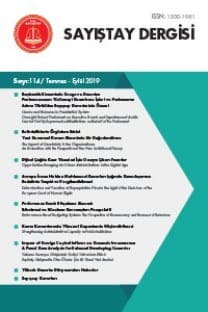Türkiye İşgücü Piyasasında Arama ve Eşleştirme Modeli
İşgücü piyasası, İstihdam, Arama ve Eşleştirme Modeli, Varyans Otoregresif Model VAR , Eşbütünleşme, Hata Düzeltme Vektörü Modeli VECM .
SEARCH AND MATCHING MODEL IN TURKISH LABOR MARKET
Labor Market, Employment, Search and Matching Model, Variance Autoregressive Model VAR , Cointegration, Vector Error Correction VEC Models.,
___
- Akpolat, A. G., Altıntaş, N. (2013), Enerji Tüketimi ile Reel GSYİH Arasındaki Eşbütünleşme ve Nedensellik İlişkisi: 1961-2010 Dönemi, Bilgi Ekonomisi ve Yönetimi Dergisi, 8, 118-127.
- Ball,, L. ve Mankiv, N. G. (2002), The NAIRU in Theory and Practice, Journal of Economic Perspectives, 16, 115–136.
- Bulut, V. (2011), Türkiye’de İşsizlik Süresini Etkileyen Faktörlerin Yaşam Çözümlemesi ile İncelenmesi, Hacettepe Üniversitesi, Yüksek Lisans Tezi, Ankara.
- Diamond, P. A. (1971), A Model of Price Adjustment, Journal of Economic Theory, 158-168.
- Dickey, D. A. ve Fuller, W. A. (1981), Likelihood Ratio Statistics for Autoregressive Time Series with a Unit Root, Econometrica, 49(4): 1057-1072.
- Engle, R. F., Granger, C. W. J. (1987), Cointegration and Error Correction: Representation, Estimation, and Testing, Econometrica, pp. 251–276.
- EViews, (2014), 8.1 User’s Guide I. Friedman, M. (1968), The Role of Monetary Policy, American Economic Review, 58 (1): 1–17.
- Friedman, M. (1977), Nobel Lecture: Inflation and Unemployment, The Journal of Political Economy, 85 (3), 451-472, Published by: The University of Chicago Press.
- Granger, C. W. J. ve Newbold, P. (1974), Spurious Regressions in Econometrics, Journal of Econometrics, 2, pp.111-120.
- İŞKUR, 2013 İstatistik Yıllığı (290-291), http://www.iskur.gov.tr/KurumsalBilgi/ istatistikler.aspx#dltop (Erişim Tarihi: 10.09.2016).
- İzmir Ekonomi Üniversitesi Yayınları, (2010), İzmir İşgücü Piyasası Araştırması, Yayın No: 46 ISBN: 978-975-8789-45-0.
- Johansen, S. (1995), Likelihood Based Inference in Cointegrated Vector Autoregressive, Oxford.
- Knuglina Vetenskaps Akademien, (2010), Markets with Search Frictions, The Royal Swedish Academy of Science.
- Martin, V., Hurn S. ve Harris, D. (2012), Econometric Modelling with Time Series: Specification, Estimation and Testing (Themes in Modern Econometrics), Cambridge University, USA.
- Modigliani, F. ve Papademos, L. (1975), Targets for Monetary Policy in the Coming Year, Brookings Papers on Economic Activity, Issue 1, 141-165.
- Öz, S. (2010), Nobel Ekonomi Ödülü: Arama ve Eşleştirme Modelleri, Ekonomik Araştırma Forumu TÜSİAD-Koç Üniversitesi.
- Petrongolo, B. ve Pissades, A.C. (2001), Looking into the Black Box: A Survey of the Matching Function, Journal of Economic Literature, 39, 390-431.
- Phelps, E.S. (1967), Phillips Curves, Expectations of Inflation and Optimal Unemployment Over Time, Economica, 34(3), 254-281.
- Sims, C. A. (1980), Macroeconomics and Reality, Econometrica, Vol. 48(1) 1-48.
- Stiglitz, J. E. (1984), Theories of Wage Rigidy, Working Paper No:1442, National Bureau of Economic Research.
- Şentürk, F. ( 2015), Türkiye’de İşgücü Piyasası ve İstihdamın Yapısı, Sosyal Güvence Dergisi 7, 113-143.
- Tokatlıoğlu, İ. (2016), Küresel Kriz Öncesi ve Sonrası Dönem İçin Türkiye’nin Beveridge Eğrisi Tahmini, Hacettepe Üniversitesi İktisadi ve İdari Bilimler Fakültesi Dergisi, 34(3), 73-105.
- Tutar, K. (2015), Türkiye İşgücü Piyasasında İş Arama Kanallarının Niteliği, İş ve Hayat Dergisi, 2, 93-106.
- Yılmaz, Z. (2013), Türkiye İşgücü Dinamiklerinin Yapısal Vektör Hata Düzeltme Modeli (SVECM) ile Analizi, EY International Congress on Economics 1 “Europe and Global Economic Rebalancing”, Ankara / Turkey
- ISSN: 1300-1981
- Yayın Aralığı: 4
- Başlangıç: 1990
- Yayıncı: T.C. Sayıştay Başkanlığı
Nimet DEMİR, Sevil BÜYÜKALAN FİLİZ
Sayıştay Yargısında Kamu Zararı Kavramı: Sorunlar ve Öneriler
Özgür ÇATIKKAŞ, Özgür M. ESEN, Cafer ŞUEKİNCİ
Kamu Yönetiminde Postmodern Savlar
Cenay BABAOĞLU, Sedat ÇOBANOĞLU
Türkiye İşgücü Piyasasında Arama ve Eşleştirme Modeli
Ömer BİLEN, Leyla BİLEN KAZANCIK, İdris DOĞAN
Türkiye’de İlaç Fiyatlandırma ve Geri Ödeme Politikalarının AB Ülkeleri ile Karşılaştırılması
Türkiye’de Kentsel Yaşam Kalitesi Göstergelerinin Analizi
